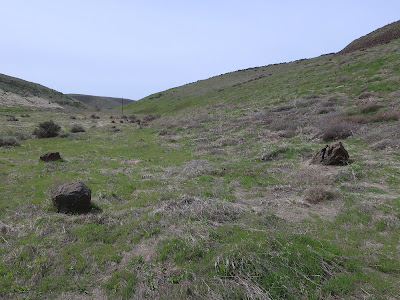In the summer of 2017, a fire burned through grass land south of Kennewick
(scrub-steppe-fire-near-kennewick). The fire was contained by previous existing roads and fast action by local fire fighters. Another fire started in the same area in the summer of 2018. Both days were hot, but the 2018 fire coincided with high winds and the result was a larger fire that jumped across roads including a state highway (with an assist fro burning paper from an illegal dump). The fire burned up onto the ridge on the south edge of Kennewick.
I noted that risk in 2017.
If the wind had been blowing this slope would have burned and posed a threat to the homes on the ridge crest.
Burned over area from the 2018 fire
This fire was primarily a grass fire, but still destroyed 5 homes as well as several other buildings.
I took a walk along the ridge crest to assess what the ground looks like 8 months later.
View of Zintel Canyon
Kennewick is a rapidly growing city and has been growing rapidly for many years. The commercial centers have shifted well away from the downtown and has pushed south past the initial line of hills south of Kennewick.
The plastic screening on the fence around the water reservoir was melted.
Somehow the perimeter of the this small ant mound makes for better grass growth.
The south side of the ridge has bedrock just below the surface. This primarily the result of high wind exposure that strips off soil. But there is a hint of periodic water erosion as well.
Rocky ground
Alignment of basalt rocks on slope
These stringers of rocky ground are more prevalent on longer and steeper slopes throughout eastern and central Washington. This south slope has barely developed these features. The features form from rather rare heavy summer down pours.
There is also an interesting anthropogenic feature on the south slope.
Metal buckets partially filled with rocks and attached to barbed wire
The buckets were formerly attached to wood fence posts to help keep them anchored in place on the rocky ground that was also subject to high winds. The fence posts and cattle are no more.
The burned over area took out the patches of sage brush that were beginning to reestablish on the ridge
Replacement power pole. Within the former sage area, the fire burned hotter and longer and took down power poles
Not a fire related phenomenon, but erosion along dirt roads is an issue. These road follow a natural gas transmission line route and a high voltage electric transmission line. The roads are just north of the crest of the ridge and underlain by thick silt related to the ice age floods that covered portions of the ridge when flood waters briefly formed a huge lake above Wallula Gap
(ice-age-floods-dem-and-lake-lewis).
The actions of gophers beneath the snow that covered this area over the winter could be seen.
These ridges of soil are a common feature in snowy areas, but it is the first time I have seen them here. Typically this area gets very little snow - its warmer than most other areas east of the Cascades, but also has very low precipitation. But this winter the snow accumulation was well over a foot and stayed on the ground for a long time.
I was curious if the snow melt caused any erosion on the steep north side of the ridge above the homes that have tucked up directly below.
Despite the complete burn off of vegetation and record snow I did not observe any surface water erosion on the steep slopes. These silt soils can hold a lot of water.
Life is coming back in the burn area. These silty soils and north aspect have all sorts of plants that go past my limited botanical knowledge base.
I did recognize lupine
An early bloomer
While water erosion is not present, wheels and wind erode deeply in these silt soils
I used to know the specific species of beetle, but it leaked out of my head.
This beetle was on a mission
As noted above, the ridge was briefly covered by water during the larger ice age floods. Those floods carried blocks of ice from the north and rocks were embedded in the ice. Hence, ice age glacial erratics are present on the ridge.
The frequency and intensity of wildfires has increased in the scrub steppe of this area. So much so that the sage brush habitat has declined. The presence of cheat grass has increased the recurrence of fires and how burned areas recover.
Just outside the burn area, there is an intact sage covered landscape. It is surrounded by roads and development and thus the large fire was not able to get into this sage stand.
























































